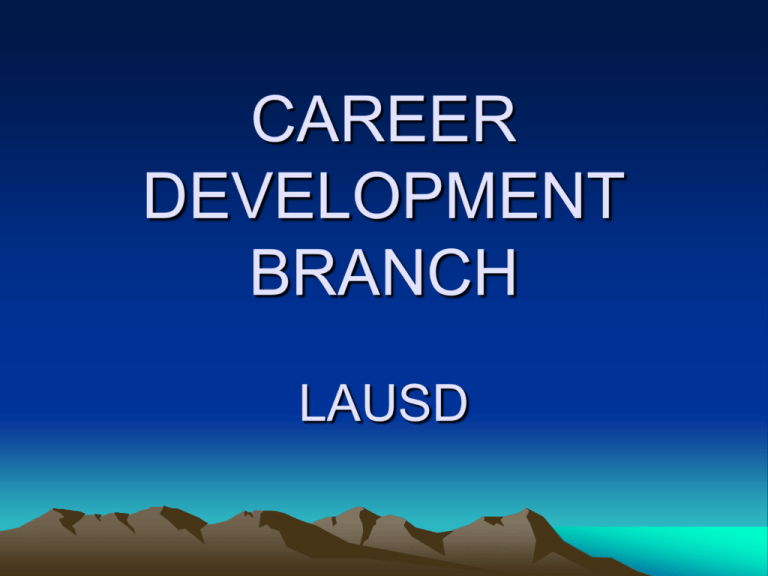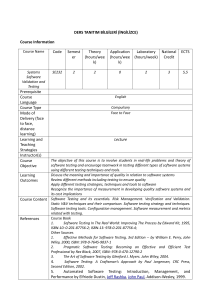CAREER DEVELOPMENT LAUSD
advertisement

CAREER DEVELOPMENT BRANCH LAUSD PROGRAMS & OFFICES 1. 2. 3. 4. 5. 6. Career Academies Non-Academy Partnerships Career Technical Education Work Experience First Break Employment Program School to Career Office 1. CAREER ACADEMIES CAREER ACADEMY MODEL School within a School – small & personal community Typically grades 10 through 12 (may include 9) Most courses restricted to academy students Integrated curriculum – academic content taught with career focus Prescribed sequence of courses Business Partner(s) with Advisory Council Dedicated counselor Teachers work as a team; plan together Mentoring – in classroom and on job sites Internships through business partners Assistance with college and job placement EXAMPLES OF ACADEMIES New Media Technology & Information Technology Human Services Junior Police Business & Finance International Trade Travel & Tourism Teaching Live Concert Production ACADEMY FUNDING MODELS California Partnership grants Qualified Zone Academy bonds School district match Private Partner match Actual dollars (not often) In-kind Donations Equipment Internship salaries Classroom visits and mentoring Salaries Career Awareness job site field trips SUCCESSFUL OUTCOMES Improved attendance More student engagement Lower drop-out rate Increased academic achievement Greater sense of community Higher rate of job placement (regardless of career or focus) Higher college attendance rates Completion rate of upper level math 1.5 X higher than peers’ (strong predictor of success in college) 2. NON-ACADEMY PARTNERSHIPS NON-ACADEMY PARTNERSHIP MODELS • • • • • • • Private / Corporate Partnership Provide services in or outside of schools Provide Basic Skills instruction when needed Provide employment training Provide mentorships Provide internships Fund scholarships for post-secondary education and/or training EXAMPLE OF NONACADEMY PARTNERSHIP #1 • Youth Service Academy (Public Non-Profit) – 11th & 12th graders from continuation high schools – Students employed at end of school day – Students work for Dept. of Water & Power & City Council offices. – DWP pays student salaries & workmen’s compensation (through contract with LAUSD). – DWP pays a school district administrator to direct program (through contract with LAUSD). – Students work for final 18 months of school and then can work six months more if in post-secondary program. – Students earn elective credit for work and on-site class. – Students must do 30 hours of community service. EXAMPLE OF NON-ACADEMY PARTNERSHIP #2 • Careers in Culinary Arts - (Private Not-for-Profit) – 9th - 12th graders from comprehensive high schools – School-based Career Pathway – Teachers integrate academic curriculum when possible. – Business partner provides teacher training. – Partner provides career-specific training off-site. – Partners provide guest speakers/chefs to schools. – Partners provide internships, mentoring, scholarships & job placement. – Students earn elective credit for sequenced classes. 3. CAREER TECHNICAL EDUCATION CAREER TECHNICAL EDUCATION is “real-life education” in that it integrates academic content into vocational content in order to prepare students to succeed in the modern world of work. The Career Development Branch oversees all Secondary CTE, which accounts for 80% of CTE dollars allotted to LAUSD. CAREER TECHNICAL EDUCATION CAREER PATHWAYS MODEL Federal Career & Technical Education grant (Carl D. Perkins) pays for counselors, teachers, professional development & equipment. Students are grouped together for instructions in careerfocused classes. Designated counselor at each high school to recruit and oversee all Perkins pathway classes Minimum of two sequential courses in career focus (introductory plus…) Technical training for teachers Provides non-traditional gender career placement Includes special populations in pathways classes Establishes a business advisory council Students participate in related workplace experiences EXAMPLES OF CAREER PATHWAYS Agriculture/Landscape design Animation Auto Mechanics Aviation Business Education Child Development Commercial Photography Computer Repair Culinary Arts Fashion Design Film Production Health Careers Home Economics Information Systems Media Production Metal Working / Manufacturing Multi-Media Multi-lingual Teaching Nutrition Science Office Occupations Ornamental Horticulture Robotics Transportation & Energy Technology Television Production Travel & Tourism 4. WORK EXPERIENCE WORK EXPERIENCE FLOW CHART RESOURCES Employer Partners Business Partners First Break Program Work Experience Education Mentored by W.E. Teacher & Worksite Supervisor Supported by standards –based classroom instruction Students earn credit and pay Work Experience Jobs developed by student or teacher W.E. Teacher issues work permit No formal supervision by teacher Students earn pay, not credit Subsidized Employment Students with special needs Government-funded Requires eligibility Non-Subsidized Employment Jobs at large Employer-funded No eligibility requirement WORK EXPERIENCE EDUCATION (WEE) WORK EXPERIENCE EDUCATION (W.E.E.) The Career Development Branch is responsible for creating, submitting and monitoring LAUSD’s Work Experience Education Plan, which is on file with the California Department of Education. Experienced Career Development staff provides Professional Development to all school-based Work Experience Teacher/ Coordinators in order to ensure program quality and compliance with mandates. KEY COMPONENTS OF W.E.E. PLAN 1. 2. 3. 4. Three Types of Work Experience Education Role of Work Experience Teacher /Coordinator & Services Provided How Students Benefit How Employer Partners Benefit 1. Three Types of W.E. Education General WEE - supervised part-time employment to assist students in developing desirable work habits and attitudes in real jobs supported by related classroom instruction. Exploratory WEE - provides unpaid opportunities to observe and sample a variety of conditions of work and related classroom instruction. Vocational WEE – provides an extension of vocational learning opportunities through parttime employment and related classroom instruction. Employment serves as a practical laboratory activity for reinforcing the school learning situation. 2. Duties of W.E. Teacher-Coordinator Approves students for enrollment in WEE. Develops written agreements which identify the responsibilities of the students, employers, parents, etc. Prepares individual training plans which outline the objectives that students are to accomplish at the work stations. Prepares related classroom instruction or guidance for each semester and for each type of WEE Makes a minimum of two on-site contacts each semester with work station supervisors. Issues or verifies work permits for students enrolled in WEE. Issues waivers for additional hours or work and extended working hours when appropriate. Maintains records as indicated in the LAUSD Secondary District Plan for WEE. Is knowledgeable of and complies with the appropriate sections of the California Education Code and other mandates. 3. Benefits to Students Enter the world of work with the support of weekly classroom instruction and mentoring from both the worksite supervisor and the WEE Teacher-Coordinator. Earn 5 to 10 elective credits per semester up to 40 credits during high school. Students behind in credits for graduation may have WEE periods 7 & 8 and make up to 20 elective credits in one year. College bound seniors may take WEE periods 5 & 6 (instead of “Home”) and show career exploration experiences to admissions personnel. Learn school-to-career skills including job-getting skills and job-keeping skills necessary to be competitive in today’s world economy. Develop a work history that will result in higher part-time salary during college. 4. Benefits to Employers WEE provides ongoing support to supervisor from experienced WEE Teacher-Coordinator WEE develops training objectives for the student worker at the worksite. WEE guarantees two on-site visits to discuss student progress in reaching worksite goals. Supplies intervention when problems at work occur. Provides a link to the parent or guardian when needed. Contributes to preparation of youth for the world of work. Hires enthusiastic employees for minimum wage. Develops a young workforce in the community. WORK EXPERIENCE SUBSIDIZED NON-SUBSIDIZED SUBSIDIZED WORK EXPERIENCE Workforce Investment Act (WIA) – Students with barriers to success (low income, reading/math deficiency, language barriers, foster home, parents with chronic unemployment, etc.) eligible – W.E. Advisors train students in job-getting and job-keeping skills. – W.E. Advisors provide case management and guidance in career pathways. – Students may stay in program throughout high school. CalWORKS TANF (Temporary Aid to Needy Families) – Students with low income qualify for paid employment – W.E. Advisors provide orientation, site supervision, payroll services, and remediation for basic skills deficiencies. General Fund Assistance Program (Mayor’s SNAP program) – Students with low income and a barrier to success qualify for employment during intersession – W.E. Advisors give orientations, approve, assign, and supervise worksites and provide payroll services. Non-Subsidized Work Experience Funded by Employer & Business Partners Jobs developed by students Jobs developed by WE TeacherCoordinators Jobs developed by First Break Office and posted on website Major employment campaigns developed by First Break Office in conjunction with employer partners (seasonal or ongoing) Jobsites must be approved by District staff. 5. FIRST BREAK FIRST BREAK WEBSITE & EMPLOYMENT PARTNERSHIPS FIRST BREAK WEBSITE Benefits to Students Benefits to Employers Benefits to Schools First Break - How Students Benefit Student searches online for jobs in their community. Student receives information about employer expectations from the WEE TeacherCoordinator at school. Student receives preparation and guidance through the application process from the WEE Teacher-Coordinator. Student receives the work permit application from the same information source. First Break - How Employers Benefit Employers list job openings for free to a large employee pool, that has part-time and full time off-track workers year round. Employers can maintain their budget by offering minimum wage to an eager young worker. Employers hire many students that are bilingual. Employers have the applicants screened by an experienced WEE Teacher-Coordinator; students do not have direct access to the employer. Employers contribute to development of a more disciplined, skilled, and experienced young workforce in the community. Employers receive follow-up contacts to ensure satisfaction with the employment process. First Break - How Schools Benefit Schools have access to worksites that have been screened and developed by the First Break Staff. Schools’ WEE Teacher-Coordinators receive training on the correct use of the website. Schools can refer parents to the First Break website for safe first jobs. Schools can enlist First Break to participate in job fairs. Schools build positive relationships with local business community. First Break Partnerships Major Employers include: Six Flags Magic Mountain – seasonal hiring Washington Mutual High School intern Program (HIP) – a two year internship Los Angeles County Registrar-Recorder Pollworker Program Six Flags Magic Mountain Seasonal hiring Recruits up to 250 students who are off-track Schools screen student applicants to ensure good attendance, grades, and citizenship. They distribute parent consent forms, work permit applications, and prepare trip slips. Orientations are conducted at the schools by personnel from Six Flags, First Break office, and the school recruiter to ensure completion of applications and preparation for interviews. Students are bused to park for interviews and are supervised by school personnel. Students are hired and travel to and from the park by Six Flags buses. Washington Mutual High School Intern Program (HIP) A two year internship Branch Managers learn about HIP at regional meetings and apply for two students. Students work part-time after school and full-time during school breaks. Students need to be self-starters, good team members, have excellent attendance, and have a 3.0 (B) average to qualify. After completion of two-year internship, students can explore regular employment at Washington Mutual. Los Angeles County RegistrarRecorder Pollworker Program One-day community service Utilized up to 25 students per high school for Presidential Election – 11/2004 High School Seniors with a 2.5 GPA recruited at school through bulletins and posters. Screened students need parental consent letters, applications, attendance at training class, and own transportation to and from the polls. Students learn first hand about the election process and later receive a stipend of $80 6. SCHOOL-TOCAREER SCHOOL-TO-CAREER Partnership between LAUSD, City of L.A and other agencies to help students transition to the world of work. The UNITE-LA office was created to promote the “School-to-Career” philosophy throughout L.A. Funded by state and foundation grants Has team to cover all areas of the city to foster educational and business partnerships that will benefit students Supports academies, pathways and other Career Development activities and programs in LAUSD schools Hosts events such as Job-Shadowing, where students visit worksites to gain exposure to the business world. Brings business professionals to schools as guest speakers to support Career Awareness Recruits business and industry partners for Career and College Fairs. SCANS SKILLS • The Secretary’s Commission for Achieving Necessary Skills (SCANS) are a list of skills and competencies that young people need to succeed in the adult world of work. • These skills: – Are transferable and apply to all jobs. – Give meaning to the work that people do – When articulated, help students understand what they’re learning and why – Show the true mission of Career Development, which is to prepare students for success in whatever career or careers they choose throughout their adult lives. APPENDIX Work-Based Learning Project-Based Learning An Instructional Model to Engage Youth by Combining Academic & Occupational Training Key Components: Student (Worker) - Centered Adults as Facilitators Focus on SCANS Skills Academic Integrated into Work Mastery of Transferable Skills Students Part of Assessment Meaningful Work Requirements: Lead-time Staff Training Mentor Training Plan (Schedule, Class v. Project) Technical Assistance Training Agreements SCANS Skills Foundation Skills & Competencies Three-Part Foundation Basic Skills Thinking Skills Personal Qualities Five Workplace Competencies Resources Interpersonal Information Systems Technology WORK-BASED MODELS Integrated Workplace & Classroom Workplace with Classroom Pull-outs Classroom Projects Job-Specific Stand-Alone MAKING CONNECTIONS Starting with Project Projects to Tasks Tasks to SCANS SCANS to Needs & Interests Needs & Interests to Training Getting to Project Needs & Interests to SCANS SCANS to Tasks (Guided) Tasks to Project (Guided) Structure Training to Fit Assessment - PORTFOLIO Work Product (memos, letters, plans) Class Product (lessons, reports) Evaluations Supervisor Teacher Self – Journals (written, video or audio) Final Product - Pictures, Videos, Manuals Resumés DESIRED RESULTS Engagement, Ownership & Pride Positive Relationships with Mentors Conscious Connections Job Skills Mastered Life Skills Enhanced Academic Achievement A Portfolio to Show the World A Real-World Success







